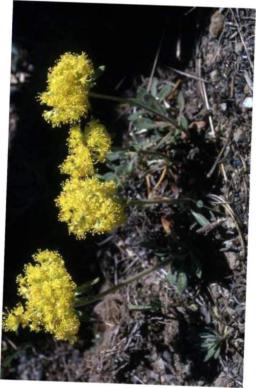Flat-Top Buckwheat
(Eriogonum smithii)

Description
Shrubs or subshrubs, spreading, rounded, occasionally erect, rarely somewhat matted, not scapose, (0.5-)1.5-8(-15) - (2-)3-15(-23) dm, grayish- to reddish-brown-tomentose to floccose or glabrous, grayish or greenish. Stems spreading or erect, often with persistent leaf bases, up to 3/ 4 or more height of plant; caudex stems absent or somewhat matted; aerial flowering stems erect or nearly so, slender or occasionally stout, solid, not fistulose, (0.1-)1-2 dm, tomentose to floccose, occasionally glabrous. Leaves cauline, 1 per node; petiole 0.1-1.5 cm, tomentose to floccose; blade lanceolate to oblanceolate or elliptic to nearly orbiculate, rarely cordate, (0.5-)1-3(-4.5) - (0.3-)0.5-3(-3.5) cm, densely white-, tannish- or brownish-tomentose on both surfaces or less so to nearly glabrous and green adaxially, margins occasionally crenulate. Inflorescences cymose, rarely capitate or umbellate, diffuse to rather open, (1-)3-20 - 2-25(-30) cm; branches dichotomous, tomentose, floccose, or rarely glabrous; bracts 3, scalelike, usually triangular, and 1-3(-6) mm, or leaflike, 10-25 mm, and similar to leaf blades. Peduncles absent. Involucres 1 per node, turbinate, (1-)1.5-3.5 - 1-2(-2.5) mm; teeth 5, erect, 0.3-1 mm. Flowers (1.5-)2-3.5 mm; perianth white to cream, pink, or pale yellow to yellow, glabrous or rarely sparsely pilose; tepals connate proximal 4- 3, essentially monomorphic, oblanceolate to spatulate; stamens included to slightly exserted, 1-4(-5) mm; filaments typically pilose proximally. Achenes brown, 2-2.5(-3) mm, glabrous except for occasional papillate beak.Varieties 8 (8 in the flora): w United States.Eriogonum corymbosum is a difficult complex of overlapping expressions, some of which are maintained here as taxonomically significant. Although perianth color is used to group the varieties, this feature is not consistent even in single populations. Therefore, population trends in perianth color must be noted in the field. Most of the varieties are then distinguished on the basis of leaf characters, and again, considerable variation can be seen in some populations. Still, the combination of flower color, leaf features, and geographic distribution should prove useful in distinguishing the varieties.
Taxonomic tree:







